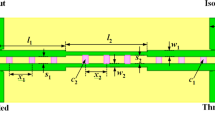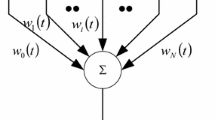Abstract
This study presents an integrated procedure using neural networks and exponential desirability functions to resolve multi-response parameter design problems. The proposed procedure is illustrated through optimising the parameter settings in the fused bi-conic taper process to improve the performance and reliability of the 1% (1/99) single-window broadband tap coupler. The proposed solution procedure was implemented on a Taiwanese manufacturer of fibre optic passive components and the implementation results demonstrated its practicability and effectiveness. A pilot run of the fused process revealed that the average defect rate was reduced to just 2.5%, from a previous level of more than 35%. Annual savings from implementing the proposed procedure are expected to exceed 0.5–1.0 million US dollars. This investigation has been extensively and successfully applied to develop optimal fuse parameters for other coupling ratio tap couplers.

Similar content being viewed by others
References
Phadke MS (1989) Quality engineering using robust design. Prentice-Hall, New Jersey
Logothetis N, Haigh A (1988) Characterizing and optimizing multi-response processes by the Taguchi method. Qual Reliab Eng Int 4:159–169
Pignatiello JJ (1993) Strategies for robust multi-response quality engineering. IIE Trans 25:5–15
Tong L-I, Su C-T, Wang C-H (1997) The optimisation of multi-response problems in Taguchi method. Int J Qual Reliab Manag 14:367–380
Antony J (2000) Multi-response optimisation in industrial experiments using Taguchi’s quality loss functions and principal component analysis. Qual Reliab Eng Int 16:3–8
Kaiser HF (1960) The application of electronic computers to factor analysis. Educ Psychol Meas 20:141–151
Lind E, Goldin J, Hickman J (1960) Fitting yield and cost response surfaces. Chem Eng Prog 56:62–68
Kim K-J, Lin DKJ (2000) Simultaneous optimisation of mechanical properties of steel by maximizing exponential desirability functions. Appl Stat 49:311–325
Harrington E (1965) The desirability function. Ind Qual Contr 21:494–498
Derringer G, Suich R (1980) Simultaneous optimisation of several response variables. J Qual Tech 12:214–219
Khuri A, Conlon M (1981) Simultaneous optimisation of multiple responses by polynomial regression functions. Technometrics 23:363–375
Hu A, Corke M, Curley J, Stowe DW (1989) Micro-fused components for communication and sensor applications. In: Proceedings of SPIE 1169:552–557
Dugan MP (1993) Passive optical branching components: increasing their reliability. In: Tekippe VJ, Varachi JP (eds) Passive fibre optic components and their reliability. Proceedings of SPIE 1973, pp 13–27
Fausett L (1994) Fundamentals of neural networks: architecture, algorithms, and applications. Prentice-Hall, New Jersey
Hagan MT, Demuth HB, Beale M (1996) Neural network design. PWS, Boston, Massachsetts
Ross PJ (1996) Taguchi techniques for quality engineering. McGraw-Hill, New York
Kirkwood CW, Sarin RK (1980) Preference conditions for multi-attribute value functions. Oper Res 28:225–232
Moskowitz H, Kim K (1993) On assessing the H value in fuzzy linear regression. Fuzzy Set Sys 58:303–327
Phadke MS, Kackar RN, Speeney DV, Grieco MJ (1983) Off-line quality control in integrated circuit fabrication using experimental design. Bell Syst Tech J 62:1273–1309
NeuralWare (2000) NeuralWorks Professional II/Plus v5.4, NeuralWare Inc, Pennsylvania
Acknowledgements
The authors would like to thank the National Science Council, Taiwan, R.O.C. for partially supporting this research under Contract No. NSC 91-2213-E-159-013
Author information
Authors and Affiliations
Corresponding author
Rights and permissions
About this article
Cite this article
Hsu, CM., Su, CT. & Liao, D. Simultaneous optimisation of the broadband tap coupler optical performance based on neural networks and exponential desirability functions. Int J Adv Manuf Technol 23, 896–902 (2004). https://doi.org/10.1007/s00170-003-1733-8
Received:
Accepted:
Published:
Issue Date:
DOI: https://doi.org/10.1007/s00170-003-1733-8




